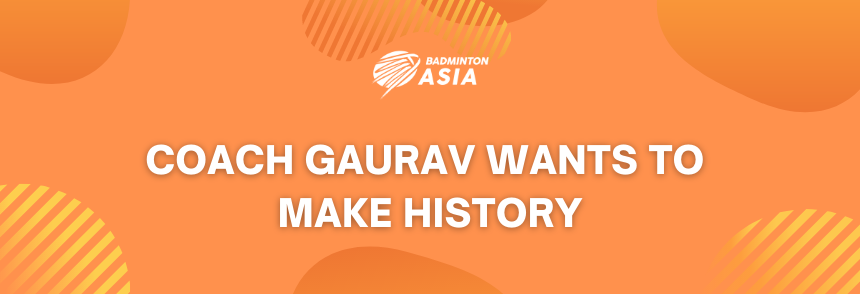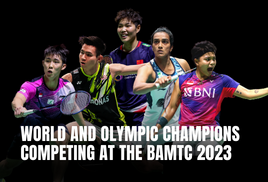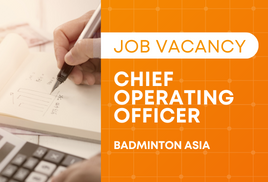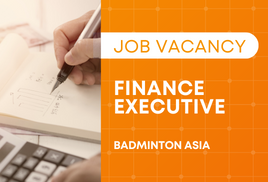Coach Gaurav Wants to Make History

The Tokyo Paralympic Games have already started and para-badminton is about to start its debut at the Paralympic Games on September 1st, 2021.
Last Sunday, Badminton Asia had the privilege of interviewing India’s para-badminton coach Gaurav Khanna and para-badminton player Palak Kohli, one of seven India’s para-badminton athletes who qualify for the Tokyo Paralympic Games. Both of them were so excited to share their personal journey, challenges and dreams and their preparation for this historical Paralympic Games in Japan.
Coach Gaurav Khanna was once a national badminton player of India whose life journey once veered away from badminton. Eventually, he made his way back and helped build India’s para-badminton success until today.
Here is the edited transcript of the interview:
Please share with us a bit of your background and tell us about your current role in para-badminton?
I was a national badminton player, and I played my last nationals in ‘88, but then I got injured there, where my leg got twisted and I had to get an operation on my knee. It was a hard time for me because I thought that my professional career was over. So I started studying and that was a crucial time because that was the time when I was at the age of graduation, and I wanted to look for some jobs and then the injury happened and it was a sad situation for me and for anyone.
I then started studying hard that time and I qualified for a few competitions and I got selected in 1998 as a cop in India. I also underwent commander training and I gave 3-4 years to my paramilitary force. After training, I got my posting at railway stations so I saw a few hearing-impaired kids. There, I saw a few beggars as well who I saw were unable to get any jobs and such so they had no other way but to ask for money. Since I was posted in a remote area, as a cop there, I tried to rehabilitate them and I saw a few small kids who were unable to speak or had different parts of their bodies missing. So I bought a few rackets and shuttlecocks for them since I was a badminton player myself, so I just used to play with them in the evening after my shift and people would be surprised that an officer was playing with the street kids but I enjoyed it that time. My passion was badminton and I sought to engage with them.
Afterwards when I received my transfer, one night I got into an accident and my other knee got injured and got operated on. I also have a certificate of disability; a permanent partial disability of the knee. This meant that I was unable to continue my commander activities because of the injury. So now that my professional badminton career is not possible, and my commander job is not possible, I started training with hearing-impaired kids.
My previous passion was with the hearing impaired badminton athletes. Since they could not speak, I learnt sign language to communicate with them. It was a long journey with them, and I helped participate and organize national and state tournaments for hearing-impaired athletes. Then, the government made me the chief coach for the Indian deaf team, and after a few competitions, in 2009 I represented the Indian team in the Chinese Taipei Deaflympics. Afterwards, I represented the country in Indonesia for Badminton Asia Pacific Deaf Games and also the World Championship in Bulgaria in 2013 as the chief coach. We’ve done a lot of development and para-badminton was also growing within the country.
Additionally, I’m also a qualified international umpire and referee for Badminton Asia. I also organized the first live scoring from Badminton Asia in Myanmar as a live scorer. And since I was the one person who has the qualified ability to become an international umpire, referee, match controller, live scorer, in 2014 at the Para Asian Games I was called by BWF to help in various factors for operations, umpiring etc. The Indian government also wanted me to be with the Indian para team so in 2015 I was made the head national coach of the Indian para team and I represented the country in the para-badminton world championships in the UK in 2015, and in 2016 I represented the country in Badminton Asia Championships in China, in 2017 the BWF para-badminton world championships in Korea and in 2018 in Indonesia and in 2019 BWF para-badminton world championships in Switzerland.
Since my journey has started, Indian players have won 337 medals in BWF recognized international tournaments, including 101 gold medals. 7 of my athletes have qualified for the Tokyo Paralympics and 2 players are #1, 2 are #2, 1 player is #3 and 9 players are under #10 in the world ranking. It’s a family and we help everyone.
I realized in India when it comes to para-sports, the level at which the players are playing and performing and delivering the results, they need the facilities like elite badminton athletes. You need equipment for recovery, hard training and other various needs. In para-badminton you need to customize the gym machines for the disabilities of the athletes and more (ie. steam baths, ice baths, hydrotherapy, physios). I realized that these things are still missing for training, so I raised a loan from my own personal capacity and prepared a place to create the first para-badminton official academy from the country. It may be small, but it’s our own and we have everything there. All the machines are customized to each disability. If an athlete is short heighted, we have made a machine that can adjust and more. We are all staying together; we have cooks staying, physios staying. Now the government has also supported us and other supporters have joined as well. The journey is here and now we are waiting for the Tokyo Paralympics.
Do you think the infrastructure system of para-badminton has been as well-established as badminton?
Recently, Badminton Asia has recruited me to train the coaches in Badminton Asia. We have customized the things as for the requirement of the different disabilities, everything is planned. We don’t want to make any differences between standing athletes and wheelchair athletes, and similarly, athlete’s with height and athletes of short stature. We just want to enforce the need to extend accessibility to everything that we have. So yes, you are right, there needs to be a thoughtful process and a person required to make amendments to have customization.
When you started coaching in the 2000s, was para-badminton already an established sport in India?
Frankly speaking, no. If you go through [para badminton’s history], up till 2012 or 2013, there were hardly any players, even in the national championships, maybe arounds 30s. In many of the categories, there was only 1 player.
Because in India there is still a social taboo and a lot of the mentality is backwards. For example, if they give birth to a girl, and especially if they have a disability, you know, something happens. It’s basically social taboo, and the general feeling is that people tend to just “pity” and be “sympathetic”. India has a huge population, and when I joined para-badminton I wondered why there were so few players in this big energy source. I want to let my voice be heard everywhere. There are so many people with challenges but they don’t know me or I don’t know them so I’m not reaching their place.
So there were a number of athlete’s in para-badminton at the time but not that many. But afterwards when I took over the charge, I also worked on this aspect with the help of the Badminton Association of India and in 2017 the entries increased to 125, then in 2018 when we organized the national championships, the entries were 240, recently in 2019 we crossed 300. Presently we have a database of more than 550 players in para-badminton in India.
Now that the sport has grown, has the taboo changed?
Yes, almost everyday I used to receive calls from the parents because social media is very strong, and we are now verified on Twitter, Facebook, Instagram. Everywhere we are followed on social media, and now people have ways to contact us. And once they contact us I would advise them on the dates and tell them to send in videos of their kids playing, disability certificates, photos and I would send them to my friends who are BWF classifiers and they would tell me which class they would fall into. So yes, the taboo has changed because of players such as Palak who have become inspirations. They learn from them and because of that they approach us.
Congratulations on having 7 athletes qualify for para-badminton! How have you been preparing for the Tokyo Paralympics?
As I’ve told you, before the 2018 Asian games we weren’t in a good condition in terms of facilities. But now we have the 1st dedicated para-badminton professional academy in India. I requested my friend to help give someplace in his school so we can construct a badminton hall there. They have extended us a helping hand to make 4 badminton courts and made it in a disabled-friendly way. We have also made a place, with the loan, where athlete’s stay together with all the facilities such as gyms, ice baths, hydrotherapy etc. Even though there was a lockdown, we did not stop, we were training. Since we already planned and observed that the situation internationally is not good, we made our own bio-bubble, so it’s a safe zone for us, and we had everything with us.
How are the athlete’s feeling about participating in the Tokyo Paralympics?
Everyone is very excited since para-badminton is making its debut in the Tokyo Paralympics. Every day there is more news on social media and we even have a few athletes who have visited there already, since the 24th is the opening ceremony and they’re already preparing for the ceremonial dresses. Everyone’s excited of course and I have to appreciate the Japanese organizers; even in such harsh conditions, they’ve been to the Tokyo Paralympics because it’s a dream for all para-athletes. After 4 years, no athletes wanted it to be postponed or cancelled. Before this batch, there were no Paralympians from para-badminton, and now after this successful organization of the Tokyo Paralympics, there will be many more Paralympians all over the world.
What are your goals for the Tokyo Paralympics?
As for the preparation, I’m proud to share that in the SL4 men’s category, there are 6 top players in the world, and out of all of them 2 of them are Indian. Similarly in the SL3 men’s category, 2 of the top players in Indian. So you can just imagine the strong presence we will have in the Tokyo Paralympics.
My realistic target is a minimum of 5 medals, including 3 golds. The categories would be gold in men’s singles SL3, SH6 and SL4. We are confident we will do well.
What is your dream for para-badminton?
In any case, we can be a successful person, we can be the President of any country or we can be a billionaire, but a person has to be a good human being first before they become a successful person. So keeping in view that we cannot do everything, and solve every problem, we at least contribute our bid to our environment and not create boundaries for ourselves.
Para badminton should not only grow in India but also abroad. There are many countries in Asia like Nepal, Maldives, Bangladesh, Pakistan and many other countries, where there will be a lot of people with disabilities who are unaware of para-badminton, and even if they know they don’t know how to get that training. I’m thankful for Badminton Asia for giving me the opportunity to train the coaches in Asia.
I believe that having the knowledge as a technical official and a coach, I should not let this knowledge be limited to myself and let it be spread around and people should be more aware of para-badminton. I should extend my helping hand so that they can start para-badminton activities in their country and every player should be penetrated with this knowledge of para-badminton. It should be an all-around development for para-badminton, and this is what I wish to have. In India, I believe I would like to increase the number of athletes to over 1,000 (active para players). There should be new players coming in, and we should be thinking about the 2028 and 2032 Paralympics. For this, I’m actively searching for young athletes to help train them for the next ticket.
Coach Gaurav Khanna’s passion for para badminton is one of the foundations for its current rise to success in India. From building a solid team to helping create facilities to help with the athlete’s needs, all of this is a result of hardwork and determination from him. Now that para-badminton has made its debut at the Tokyo Olympics, this will only create further buzz and anticipation for the sport, which will hopefully lead to more interest in it. Coach Khanna is at the forefront of the sports push for more success and accessibility worldwide.
Badminton Asia also had the privilege to interview Palak Kohli, one of seven of India’s para-badminton athletes who qualified for the Tokyo Paralympic Games. Next week, Badminton Asia will share her story of being a para badminton athlete and her journey of perseverance and triumph, to get to where she is now.





